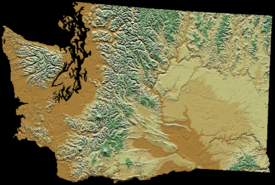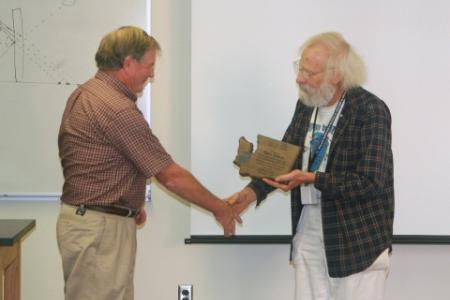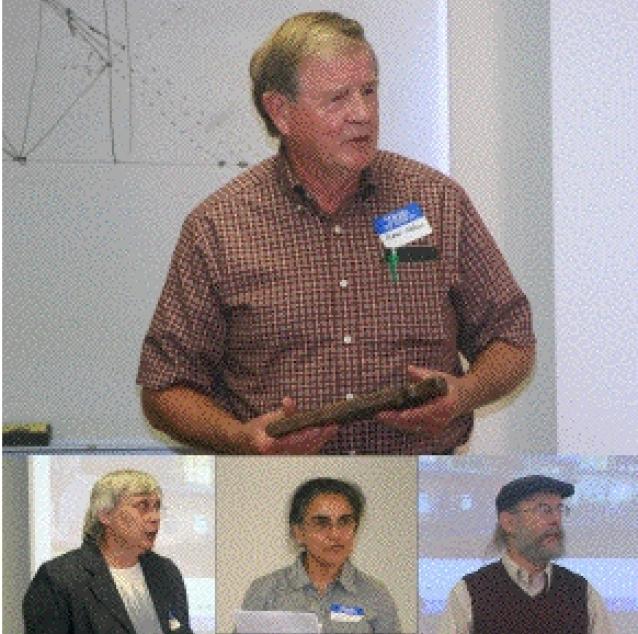Scroll over menu items for submenu selections.

AAPT Washington
Report of the Annual meeting of Washington Section of APPT: October 2011
| |
Friday workshops are expanded and Marv Nelson receives the Distinguished Service Award
Also, AAPT goes to NSTA
 |
Marv Nelson receives the Joel Shaff Distinguished Service award. The presenter is Joel Shaff the AAPT member for whom the award is named. Marv was recognized for his long service to both the local and national AAPT organizations and his outstanding contributions to physics teaching. (see below)
|
Meeting highlights included an expanded program of workshops on Friday and the awarding of the Joel Shaff Distinguished Service Award to Marv Nelson.
The Friday program continued our recent practice of offering afternoon and evening workshops on Friday before the normal Saturday meeting. The workshops this year expanded since last year and included hands-on exposure to probeware with an eye to moving away from cookbook labs, and a wind energy project that can be adapted to other forms of alternative energy. Jeff Hashimoto from Ellensburg High School Presented the probeware workshop and Michael Braunstein and Michael Jackson of CWU took the participants through their wind energy project.
After the evening Pizza break, participants learned about new dynamic energy representations being developed at Seattle Pacific University (SPU) where they have been shown to promote a more rigorous discourse among students than standard representations. Stamatis Vokos of SPU led this workshop. This was followed by an observance of International Observe the Moon Night, celebrated by..... wait for it.... Observing the moon! Bruce Palmquist of (CWU) hosted this event where participants viewed the moon and other celestial objects at the CWU Observatory.
The fall meeting of the Washington section of AAPT (WA-AAPT) was held in Lind Hall at Central Washington University (CWU) Friday and Saturday October 7-8 2011.
Saturday's sessions opened with a morning theme that focused on supporting effective teaching and outreach, both to promising new STEM candidates and to high school teachers. The first session described a comprehensive cohort program at CWU aimed at attracting and retaining science technology and engineering (STE) students. One unique feature of the Science Talent Expansion Program (STEP) is the multiple entry points approach. Students just beginning college start with the STEP 101/102/103 Freshman seminar, while transfer students have courses, STEP 301-302, that help them get connected to the department, other students, and faculty research. Michael Braunstein and Andy Piacsek from CWU presented.
This was followed by a description/discussion of Mechanisms for Regional Collaboration in Physics Education Research led by Andrew Boudreaux, Western Washington University (WWU). Two elements that already exist are the annual Foundations and Frontiers of Physics Education Research: Puget Sound (FFPERSPS) conference and a model for professional exchanges hosted on the web by Amy Robertson at www.perx.org.
|

|
Marv Graciously accepts his award following testimonials from Sharon Roselle, Chitra Solomonson, and Robert Hobbs. (shown left to right)
|
Andy was followed by Stamatis Vokos from SPU who described the Learning Assistant (LA) preparation program at SPU (this is a Physics Teachers Education Coalition (PTEC) program). Stamatis quickly led the discussion into opportunities for collaboration which provided a nice set up for Bruce Palmquist from CWU to describe their Center for Excellence in Science and Mathematics Education (http://www.cwu.edu/~cesme/) and its role in teacher preparation at Central Washington University.
Recognizing that these presentations have a common thread a group discussion had been scheduled at this point. It was quickly apparent that the interest and diversity of ideas and issues would more than fill the time so it was agreed that we would convene in a special session after the business meeting in the afternoon (see below).
After a plug for the WA-AAPT production of a physics day of activities for the regional National Science Teachers Association (NSTA) meeting in Seattle on December 9th we broke for refreshments. (See report below.)
Briana Ponzer presented another in a sequence of interesting talks on student difficulties with ratio reasoning originating from the physics education research efforts of Andrew Boudreaux at Western Washington University. The talk, "Rates in unfamiliar circumstances: Investigating student reasoning abilities," Challenged students (and attendees!) to interpret such ratios as 0.1 s2/m (the inverse of an acceleration) and provided a context for productive instruction around learning ratios.
Darren Collins of Tahoma High School Described his experiences with "FIRST Robotics". Dean Kamen (Segway Inventor) organized the "For Inspiration and Recognition of Science and Technology" (First) initiative 20 years ago. "FIRST Robotics" is one of their activities. Darren related his experiences as a physics teacher describing the young people involved (not physics oriented) and how he was able to show many of them that physics was within their ability and how a systematic approach, often using math, was preferable to trial and error. He cited Usfirst.org and firstwa.org for those of us who wanted to follow up.
Under the title "Atoms are Fictions of the Chemists" Sharon Rosell, Central Washington University, provided an historical account of the atomic theory noting that it is 100 years since Curie's Nobel Prize and Rutherford's experiments and that 2011 is the international year of Chemistry.
Mirrors and laser pointers were then distributed for an interactive lecture demonstration example by Robert Hobbs of Bellevue College. The activity illustrated how inquiry style instruction in methodology can be strongly re-enforced with a hands on example that explains a curious observation. As implemented in class the second half of the observational puzzle is explained by the students as they employ the methodology outside of class as homework.
The historical perspective is taken up again by Robert Ruotsalainen of Eastern Washington University as he brought us up to currency with Initial Mass Functions used in stellar evolution.
Henrique Alves, a student of Michael Jackson at Central Washington University (and Bellevue College Alumnus) described the assembly and operation of a Far-Infrared Laser Cavity. This excellent presentation of an optically pumped Molecular (CO2) Laser illustrated the excitement that is generated by successful undergraduate participation in research.
The regular meeting was concluded with the presentation of the Joel Shaff Distinguished Service Award.
Long time member Marv Nelson was recognized for his outstanding contributions to the Washington Section of AAPT where he is acknowledged as being instrumental in keeping the organization going through rough periods in its early years. Marv was awarded the Outstanding Introductory College Physics Teacher of the year in 1999 by the national AAPT, the first time this award was presented to a two year college faculty member. He was also instrumental in establishing the Two Year College Committee in the national organization and as well as the TYC21 initiative. Marv taught physics for more than 30 years at Green River Community College where his contributions to their physics program have been memorialized in the dedication of the Marv Nelson Science Learning Center in 2007. The Green River physics program was chosen as one of ten exemplary Two Year College programs by the SPIN UP project of the AAPT. Congratulations Marv!
Following presentations, the event was concluded with the
annual business meeting. Following the approval of the minutes and the treasurers report there was a discussion to raise meeting rates next year. It was decided that registration (membership) rates would be raised from $10.00 to $15.00 next year. High School teachers would not have to pay for registration during the first year and Society of Physics Student members can attend the meetings for free.
Several organization activities were then announced:
- AAPT Physics Day at NSTA: AAPT-WA will host an independent booth at the NSTA Area conference to be held in Seattle on December 8 - 10. Michael Jackson, Sara Sepehri and Robert Hobbs are working on putting this together.
- WA Science Teachers Association (WSTA): It was suggested that we should make a greater effort to reach out to High School teachers in WA state. Robert Hobbs and Stamatis Vokos plan to attend the WSTA meeting in March.
- Pacific Northwest Association for College Physics (PNACP): The next meeting will be held in Spring 2012 in Bellevue College. Robert Hobbs invited the members to attend.
- Tom Haff announced that he hopes to start a monthly meeting of serious High School Physics Students at Issaquah High School and sought the blessing of AAPT-WA to do so. This generated enthusiastic discussion around activities and possible speakers. Michael asked Tom to make a record of the dates of these meetings and track the students who show up.
- Northwest Undergraduate Women in Physics Conference - This will be held from January 13 -15 at the University of Washington.
- The next AAPT-WA section meeting will be hosted by Western Washington University.
|
The meeting adjourned and the conferees split into two tour groups according to their interest in Central Washington’s facilities while the remainder stayed in Lind Hall for a "Fellow Travelers" meeting around issues related to teaching physics, teacher preparation, and establishing a learning community among physics teachers.
Early in this session Briana Ponzer and Kristen Larsen contributed ideas for getting new teachers connected to AAPT early on in their careers. Stamatis Vokos provided a detailed and revealing overview of the status of K-20 communication around the state describing locations and programs that are vibrant and areas where isolation is the norm. A wide ranging discussion around networking ensued. Primary/secondary/college as well as two-year four-year linkages were discussed as well as strategies for identifying faculty for involvement in a mentoring community.
Andrew opened a discussion of institutional factors, both structural and cultural elements will need to be addressed. How do we build an environment that embraces a focus on producing the new faculty we need nationwide?
Robert suggested developing materials and programs for a slightly scaled down LA position at two year colleges. Providing instruction and mentoring for student tutors who then are associated with a specific instructor and class section helps other students and produces a visible role model for teaching as a career objective. Transfer links from these programs to Schools with solid physics teacher preparation can then be strengthened.
|
|
This was the end of the Fall AAPT meeting. Two months later Friday, December 9, we came together again to produce the program for a physics day at the regional NSTA meeting in Seattle,WA. Shown after the presenter is an attendance estimate.
- Invention Tasks That Promote Proportional Reasoning Skills in Physics and Physical Science
Presenter(s): Andrew Boudreaux (Western Washington University: Bellingham, WA)
[Attendance ~ 55]
- Putting Student Energy to Use with a Bike Generator!
Presenter(s): Cecilia Tung (The Northwest School: Seattle, WA)
[Attendance ~ 65]
- Physics by Inquiry: A Guided Inquiry Curriculum
Presenter(s): Lillian C McDermott, Peter Shaffer (University of Washington: Seattle, WA)
[Attendance ~ 70]
- Engaging Independent Projects to Teach Energy
Presenter(s): Michael Braunstein, Michael Jackson (Central Washington University: Ellensburg, WA);
[Attendance ~ 45]
- Active Learning of Introductory Optics: Interactive Lecture Demonstrations and Optics Magic Tricks
Presenter(s): David R. Sokoloff (University of Oregon: Eugene, OR)
[Attendance ~ 80]
- Interactive Lecture Demonstrations for Smaller Classrooms
Presenter(s): Robert Hobbs (Bellevue College: Bellevue, WA)
[Attendance ~ 30]
|
|
This program was very successful and well received by participants. Most presentations incorporated audience participation and the attendees joined in with enthusiasm right through to the last program in spite of the late hour on a friday at the end of the conference. WA-AAPT thanks the NSTA for the invitation.
|
| |
|
|
|
|

|
|
|
| |